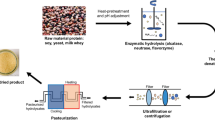Abstract
Technical limitations and evolution of therapeuticapplications for cell culture-derived products haveaccelerated elimination of animal-derived constituentsto minimize inadvertent introduction of adventitiousviral or prion agents. Practical considerationsdemand adequate emphasis both on design of theserum-free/protein-free culture environment and onnutrient media manufacturing process controls. Protein components may be acceptable, given adequateattention to synthetic process, sourcing (e.g.,geographic location and endemicity, species andtissue/organ) and validated treatment method. Variousoptions exist for re-engineering of traditionalserum-free formulations (containing insulin,transferrin and other protein factors) withnon-protein substitutes. Caution must also beexercised with sourcing of non-protein additives,particularly amino acids and lipids, to avoidintroducing adventitious contaminants. Simpleguidelines facilitate adaptation, cryopreservation andrecovery of many cell types within a protein-freeculture environment. Scrupulous maintenance offacility and equipment and monitoring of processwater, air handling systems and technical personnelare required to ensure that approved raw materials arecorrectly formulated and dispensed. Validatedsanitization processes provide additional assuranceagainst cross-contamination from previous batches ina multi-use facility.
Similar content being viewed by others
References
Bader F, Davis G, Dinowitz M, Garfinkle B, Harvey J, Kozak R, Lubiniecki A, Rubino M, Schubert D, Wiebe M and Woollett G (1998a) Assessment of risk of bovine spongiform encephalopathy in pharmaceutical products, Part 1. BioPharm 11: 20–31
Bader F, Davis G, Dinowitz M, Garfinkle B, Harvey J, Kozak R, Lubiniecki A, Rubino M, Schubert D, Wiebe M and Woollett G (1998b) Assessment of risk of bovine spongiform encephalopathy in pharmaceutical products, Part 2: Example risk assessment for a hypothetical product. BioPharm 11: 18–30.
Darling AJ and Spaltro JJ (1996) Process validation for virus removal: Considerations for design of process studies and viral assays. BioPharm 9: 42–50.
Federal Ministry of Health (Germany) (1994) Guidelines on safety measures in connection with medicinal products containing body materials obtained from cattle, sheep, or goats from minimizing the risk of transmission of BSE and scrapie. Federal Bulletin No. 40.
Fike RM, Pfohl JL, Epstein DA, Jayme DW and Weiss SA (1991) Hybridoma growth and monoclonal antibody production in protein-free hybridoma medium. BioPharmacology 4: 26–29.
Gorfien SF, Dzimian JL, Tilkins ML, Godwin GP and Fike RM (1998) Recombinant protein production by CHO cells cultured in a chemically defined medium. In: Nagai K and Wachi M (eds), Animal Cell Technology: Basic and Applied Aspects, Vol. 9, (pp. 247–252). Kluwer Academic Publishers, Dordrecht.
Jayme DW, Kubiak JM, Battistoni TA and Cady DJ (1996) Continuous, high capacity reconstitution of nutrient media from concentrated intermediates. Cytotechnology 22: 255–261.
Price PJ and Evege EK (1997) Serum-free medium without animal components for virus production. Focus 19: 67–69.
Ziomek CA (1996) Minimization of viral contamination in human pharmaceuticals produced in the milk of transgenic goats. Dev Biol Stand 88: 265–268.
Author information
Authors and Affiliations
Corresponding author
Rights and permissions
About this article
Cite this article
Jayme, D.W., Smith, S.R. Media formulation options and manufacturing process controls to safeguard against introduction of animal origin contaminants in animal cell culture. Cytotechnology 33, 27–36 (2000). https://doi.org/10.1023/A:1008133717035
Issue Date:
DOI: https://doi.org/10.1023/A:1008133717035




